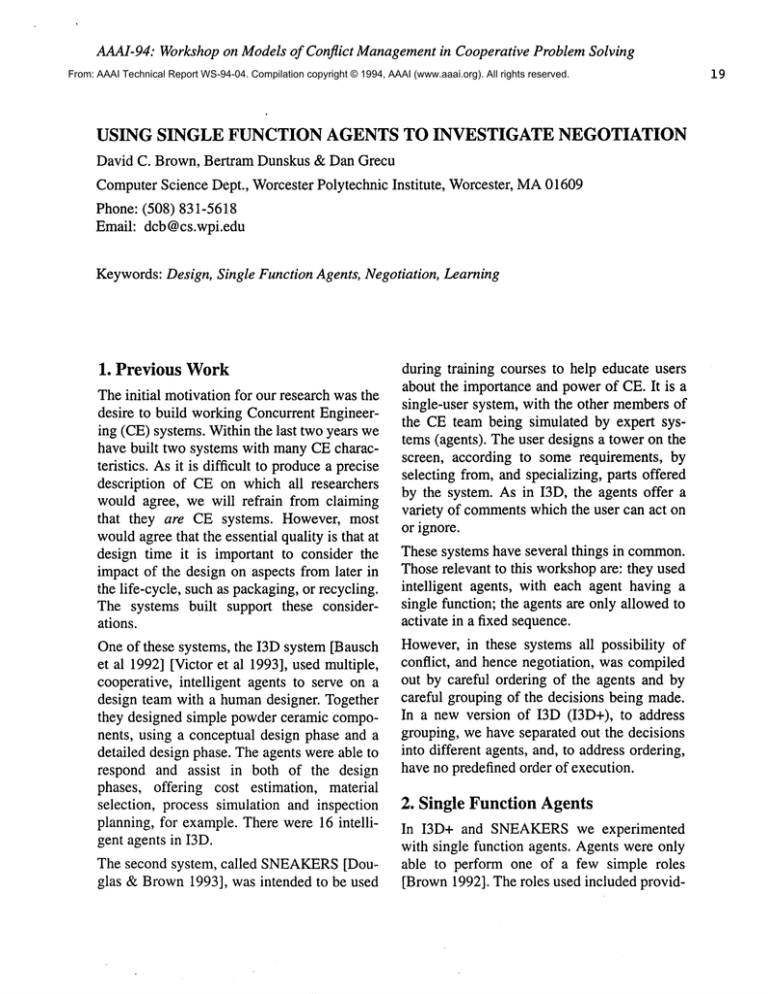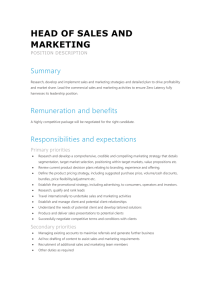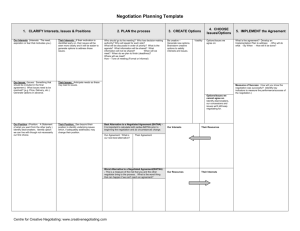
AAAI-94: Workshopon Models of Conflict Managementin Cooperative Problem Solving
From: AAAI Technical Report WS-94-04. Compilation copyright © 1994, AAAI (www.aaai.org). All rights reserved.
USING SINGLE FUNCTION AGENTS TO INVESTIGATE NEGOTIATION
David C. Brown, Bertram Dunskus & Dan Grecu
ComputerScience Dept., Worcester Polytechnic Institute,
Worcester, MA01609
Phone: (508) 831-5618
Email: dcb@cs.wpi.edu
Keywords:Design, Single Function Agents, Negotiation, Learning
1. Previous Work
Theinitial motivation for our research wasthe
desire to build working Concurrent Engineering (CE) systems. Within the last two years
have built two systems with manyCE characteristics. As it is difficult to producea precise
description of CE on which all researchers
would agree, we will refrain from claiming
that they are CE systems. However, most
wouldagree that the essential quality is that at
design time it is important to consider the
impact of the design on aspects from later in
the life-cycle, such as packaging,or recycling.
The systems built support these considerations.
Oneof these systems, the I3D system [Bausch
et al 1992] [Victor et al 1993], used multiple,
cooperative, intelligent agents to serve on a
design team with a humandesigner. Together
they designed simple powder ceramic components, using a conceptual design phase and a
detailed design phase. Theagents were able to
respond and assist in both of the design
phases, offering cost estimation, material
selection, process simulation and inspection
planning, for example. There were 16 intelligent agents in I3D.
The second system, called SNEAKERS
[Douglas & Brown1993], was intended to be used
during training courses to help educate users
about the importance and powerof CE. It is a
single-user system, with the other membersof
the CE team being simulated by expert systems (agents). The user designs a tower on the
screen, according to some requirements, by
selecting from, and specializing, parts offered
by the system. As in I3D, the agents offer a
variety of commentswhich the user can act on
or ignore.
These systems have several things in common.
Thoserelevant to this workshopare: they used
intelligent agents, with each agent having a
single function; the agents are only allowed to
activate in a fixed sequence.
However,in these systems all possibility of
conflict, and hence negotiation, was compiled
out by careful ordering of the agents and by
careful grouping of the decisions being made.
In a new version of I3D (I3D+), to address
grouping, we have separated out the decisions
into different agents, and, to address ordering,
have no predefined order of execution.
2. Single Function Agents
In I3D+ and SNEAKERSwe experimented
with single function agents. Agents were only
able to perform one of a few simple roles
[Brown1992]. The roles used included provid-
Brown, Dunskus & Grecu
20
ing Advice, Analysis, Criticism, Estimation,
Evaluation, Planning, Selection and Suggestion.
These roles can be contrasted with the target
about which they can make comments. For
I3D+ these include Material, Process, Manufacturing, Inspection, Cost, Reliability and
Durability. The roles and targets define a 2D
matrix of possible agents, not all of whichare
sensible.
In I3D+we refined this further by considering
another axis, point-of-view, thus classifying
agents using a 3Dmatrix (i.e., role, target,
point-of-view). For example, one agent might
producecriticism (role) of material (the target)
from the point-of-view of cost. Note that, as
before, not every combination is sensible.
However,this system allows us to quite precisely define every agent in the system. It will
also force us to be very explicit about what
each agent can do, and what it knows, while
allowing us freedom to implement the agents
in any way appropriate, provided they play
their appointed role. Werefer to these limited
agents as Single Function Agents, or SiFAs.
Weconsider the functionality to be moregeneral than target and point-of-view. The function defines the agent, and the two other
aspects are instantiating it at the domain
level. As we experiment with negotiating
SiFAs,it is possible that wewill discover that
newfunctions will be required, or that someof
our current list of functions should be split or
combined. Wewould like to discover the most
appropriate level of granularity for design systems involving negotiation.
Weexpect to learn a lot about the roles of different types of knowledgein different negotiation schemes. Wehave already added Praisers
to the list of types of roles. Wheregroupingof
decisions allowed us to avoid negotiation in
I3D and SNEAKERS,
this approach of strict
separation of role will force us to face negotiation directly and in detail.
For example,it is already clear that Critics
and Estimators interact in interesting ways
with the agents doing design (Advisors),
allowing several ways to negotiate between
them. For example,a critic can criticize an
estimate: what do they negotiate about? Perhaps the methodof estimation? Or the data
used? CanCritics conflict? Whatif Praisers
and Critics disagree?
This research will investigate the possibilities and implications of the SiFA concept,
analyzing the communication language,
negotiation and strategies available to the
agents. Wehypothesize that negotiation
between the agents becomes simpler with
SiFAsthan it is with agents of larger size.
This is because SiFAsheavily constrain the
possible types and topics of negotiation.
Negotiation knowledgemight even be stored
in a pattern oriented representation, speeding
up the problem-solving process and simplifying the design. The resulting "dissection"
of negotiation should moreexplicitly reveal
the trade-offs being madeduring the design.
Wealso expect to discover generic patterns
of use of functions in the negotiation process. For example, it maybe that certain
types of conflicts, and therefore certain types
of negotiation, are always associated with
the sametype of cluster of SiFAs. This sort
of observation about the nature of negotiation between agents would only be possible
with functions at this level of granularity.
Weexpect to be able to show by using templates, and an object oriented implementation using inheritance, that SiFAsof similar
type share characteristics. This should lead
to ease of development of SiFA systems,
some reuse of SiFAs, and the possibility of
using small KnowledgeAcquirers tuned to
each type of SiFA, and perhaps to types of
conflicts and negotiation knowledge.
Brown, Dunskus & Grecu
21
3. Current Research Directions
Current research is proceecling in two directions. Thefirst is to study SiFAsystemsto see
what kind of communicationand negotiation
arises naturally, and build implementationsto
explore this. The second direction, longer
term, is to study howSiFAagents might learn
by exchanging goals and knowledge.
3.1 A Study of Negotiation in SiFAs
After defining a domain independent set of
agents we will investigate negotiation, analyzing which pairs/groups of agents would have
reason to communicate,and what the information passed between them should be. Then we
will investigate the patterns of messagesthat
will appear and the kinds of knowledgethat
are needed for the negotiation. Knowledge
representation will be an issue here. If possible, a catalog of conflicts for Single Function
agents, with attached methods of resolution
will be developed. Finally, wewill look at how
mucha negotiation history wouldbe of help to
the agents.
Whatis the performance of a system based
on SiFAs, comparedto a system with a larger
agent size?
The expected outcomes from this short-term
workare:
Implementation of a Communication Language: A language for interagent communication for SiFAs, probably based on the KIF
and KQML
standards [Genesereth & Fikes
1992][Finin et al 1993].
Hierarchy of Conflict Situations: A compilation of all conflict situations opento negotiation, in hierarchical fashion, similar to
Klein’s work [Klein 1991], but specialized
for SiFAs.
Suggestions for future development and
implementation of SiFAs: Supportive information for applications and research.
3.2 Learning with SiFAs
Expert Opinion: Does the agent negotiation
make sense to a human,i.e., is the process
understandable at run-time, would a human
agree on the outcome, and could one easily
read the knowledgerepresentation?
Single function agents are supposedto allow
the definition, implementation, testing and
evaluation of elementarypatterns of conflict,
communicationand negotiation. In order to
generate such patterns agents are classified
according to their functionality, domainand
point of view. Assumingthat the possible
patterns of conflict are established, one first
step further would be to explore what the
agents can share along each of these dimensions. This is important in order to determine
what an agent can understand about another
agent. Functionality sharing can meanunderstanding of design or critiquing strategies, a
commondomain would possibly allow for
exchange of domain rationale, while common points of view are based on similar
goals.
Performance: What is the overhead incurred
through negotiation? Whereis that overhead
with respect to types of SiFAs? Howdoes the
amountof conflict affect the run-time?
This research will attempt to lay the groundwork for a frameworkfor learning during,
and due to, SiFAnegotiation. Weare considering the followingpossibilities:
Comparison to other negotiating
¯ Knowledgeabout another agent allows one
Because the research strives to extend and
solidify previous ideas about SiFAs, it will be
fairly difficult to evaluate the workas success
or failure. However,the following criteria can
help whenevaluating the outcome:
Comparison of the design objects: Howgood
is the quality of the object designed by the
negotiating system, as comparedto non-negotiating systems?
systems:
Brown, Dunskus & Grecu
22
agent to build a modelof the other agent’s specific intentions and beliefs- In the case of
SiFAs, such models can be easily kept within
reduceddimensions,assumingthat the classification of the other agent is known.
¯ Understanding the other agent’s domain/
goal/functionality can help the agent define
expectations about the other agent.
¯ This understanding helps anticipate possible
conflicts between agents. Reasoning to this
purpose can result in the compilation of negotiation knowledge.
¯ Negotiating with different types of agents
could generate learning about how to adequately select/construct negotiation strategies.
Success of negotiation is highly dependent on
finding a wayto negotiate whichis suitable for
both parties involved.
¯ Negotiating is a rich source of learning how
to relate intentions of another agent to his
functions, goals (and, if known,beliefs).
¯ The SiFAmodelis supposedto offer a clear
overviewof the sources of conflict and of the
negotiation. Extended explanation facilities
about the conflict and the negotiation process
can be implemented. Agents should also be
sensitive to learning generic patterns of conflict generatingsources.
The necessary
exchange of knowledge
betweenthe agents to achieve these goals does
not conflict with their restricted functionality.
The negotiation-related
communication is
assumed to take place at a meta-knowledge
level and does not contradict with their domain
functionality.
Further potential advantages of SiFAarchitectures wouldbe the developmentof "pure" utility functions. Such functions would reflect
well-defined positions in the agent space and,
together with a combination method, would
offer a more accurate determination of the
negotiationresult.
Single-function agents research is eventually
supposedto provide an insight into efficient
function, domain or view combinations in
the attempt to define complexagents. Superimposing single-function agents (possibly
through coalition formation) might be a relevant method to produce such agents. We
hypothesize that patterns of negotiation will
help identify which agents could be put
together to form complexagents. It mayalso
be possible to identify types of complex
agents dependent on which SiFAs they contain.
4. Conclusion
Despite some very interesting work on computational modelsof negotiation -- such as
that by Sycara [1990], Lander & Lesser
[1992], Klein [1991], Werkman[1992], Kannapan & Marshek [1992], and others -- we
feel that there is still muchto be done.
Despite having contacted many people
directly and via email, one surprise is that
there appear to be very few implementations,
few computational models, little evaluation
of the systems, and no comparative evaluation.
We will test our hypotheses about the
expected advantages of SiFAs by building
design systems in several areas, and will try
to compare them with non-negotiating versions of the systems.
Weconsider that a methodological disadvantage of complexagents is that they can span
several domains/functions/points of view.
The possibility of classifying agents according to these criteria is highly improbableand
therefore learning to associate intentions and
beliefs with functions and goals maybe less
straightforward than in the SiFAcase.
In the negotiation process an agent has to:
a) acquire knowledgedescribing and defining the other agent (part of whichis implicit
in the single function case assumingthe type
of the other agent is known);
Brown, Dunskus & Grecu
23
b) learn howto react to possible pattems of
intentions/beliefs/functions/goals
and form
expectations;
c) abstract general negotiation answers and
compilenegotiation strategies.
Wefeel that it will be profitable to proceed
with knowledge acquired during negotiation
with single function agents and then to compose elementary negotiation strategies for
complex agents, rather than by starting the
learning process directly with complexagents.
5. References
J.J.Bausch, D.C.Zenger, D.C.Brown, R.Ludwig & R.D.Sisson (1992) Integrated Design
and Manufacturing Strategies for PowderProcessing Applications. Proceedings, University
Programs in Computer Aided Engineering
Design and Manufacturing (UPCAEDM’92),
Tennessee Technological University.
D.C.Brown (1992) Design. Encyclopedia
Artificial Intelligence, 2nd edn., S.C.Shapiro
(Ed.), J.Wiley.
R.E.Douglas & D.C.Brown (1993) A Concurrent Engineering Demonstration System for
use in Training Engineers and Managers.Proc.
AI in Engineering Conference.
T.Finin, J.Weber, G.Wiederhold, M.Genesereth, R.Fritzon, D.McKay, J.McGuire,
R.Pelavin,
S.Shapiro & C.Beck (1993)
DRAFTSpecification
of the KQML
AgentCommunication
Language,
The DARPA
KnowledgeSharing Initiative External Interfaces WorkingGroup.
M.R.Genesereth & R.E.Fikes (1992) Knowledge Interchange Format Version 3.0 Reference Manual, Computer Science Dept.,
Stanford University, CA94305.
S.M.Kannapan & K.M.Marshek (July 1992)
Schemafor Negotiation between Intelligent
Design Agents in Concurrent Engineering. In:
D.C.Brown, M.Waldron & H.Yoshikawa
(Eds.), Intelligent ComputerAided Design,
Elsevier Science Publishers (North-Holland).
M.Klein (1991) Supporting conflict resolution in cooperative design systems. IEEE
Trans. Systems, Man, and Cybernetics,
November/December, Vol. 21, No. 6, pp.
1379-1390.
S.E.Lander & V.R.Lesser (1992) Customizing Distributed Search amongAgents with
Heterogeneous Knowledge. Proc. 5th Int.
Symp. on AI Applications in Manuf. &
Robotics, Cancun, Mexico.
K.P.Sycara (1990) Cooperative Negotiation
in Concurrent Design. In: Cooperative Engineering Design. Springer Verlag.
S.K.Victor,
D.C.Brown, J.J.Bausch,
D.C.Zenger, R.Ludwig & R.D.Sisson (1993)
Using Multiple Expert Systems with Distinct
Roles in a Concurrent Engineering System
for Powder Ceramic Components. Proc. AI
in Engineering Conference.
K.J.Werkman(1992) Multiple Agent Cooperative Design Evaluation using Negotiation.
In: J.S.Gero (Ed.), Artificial Intelligence
Design ’92, KluwerAcademicPublishers.




